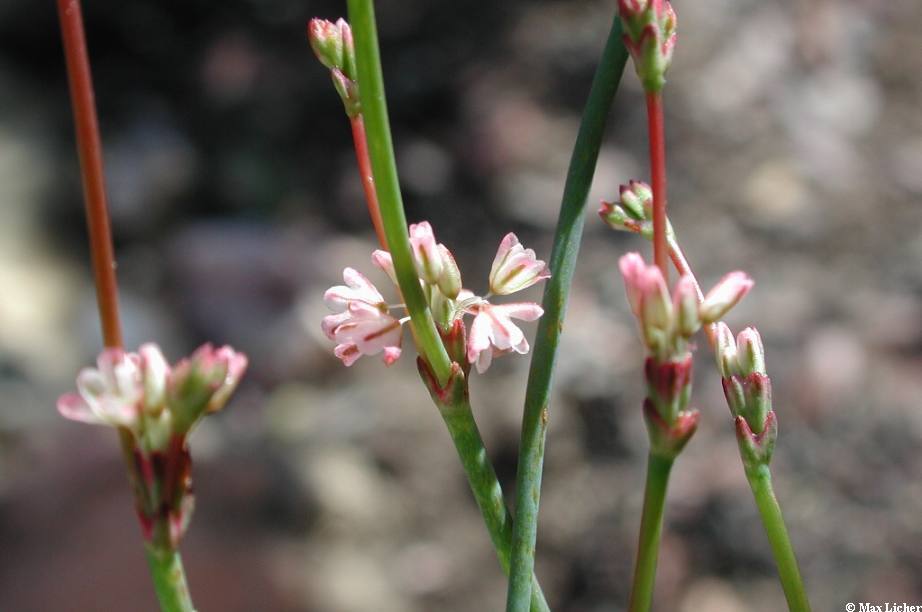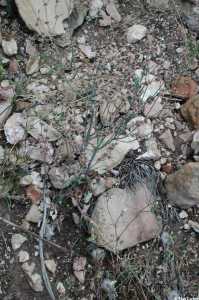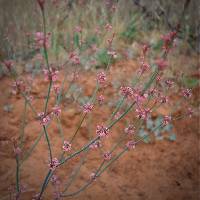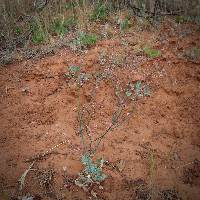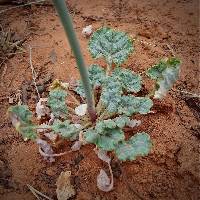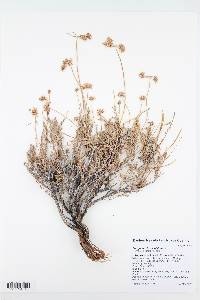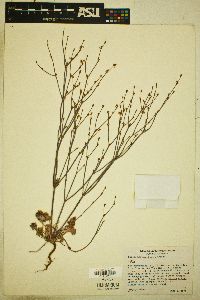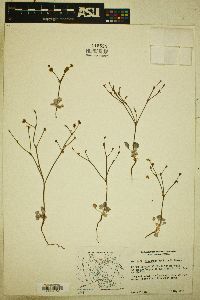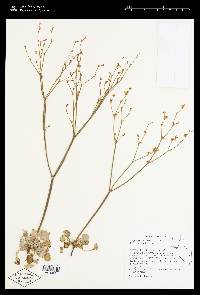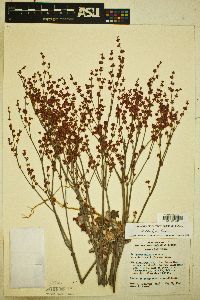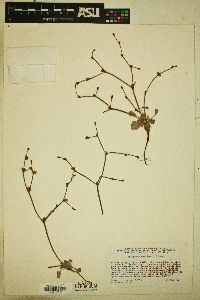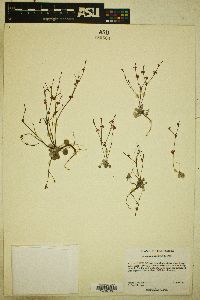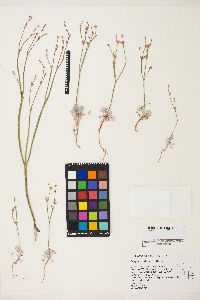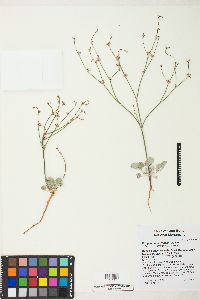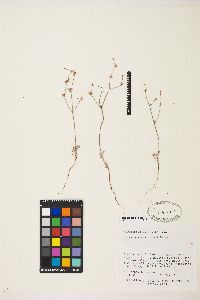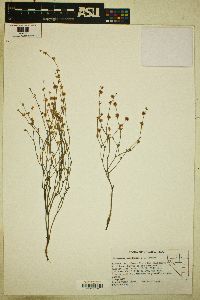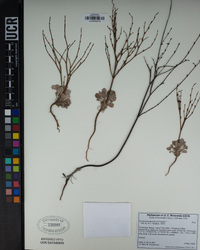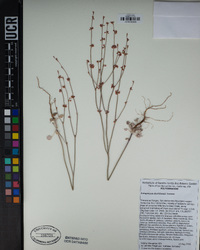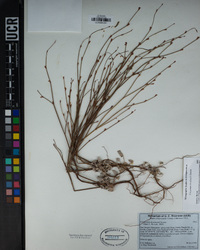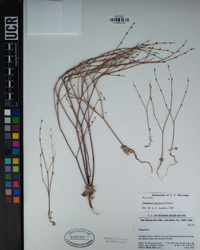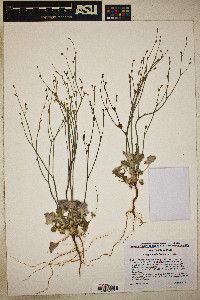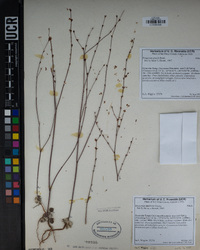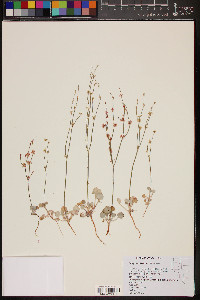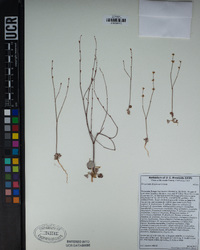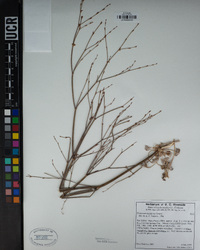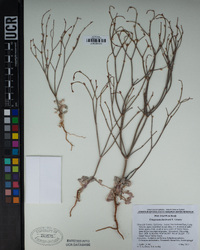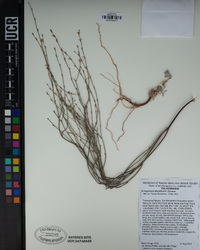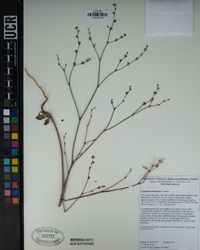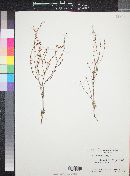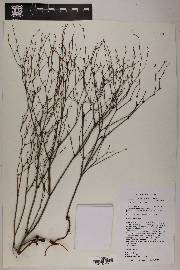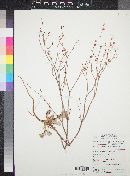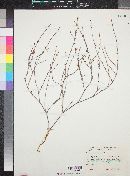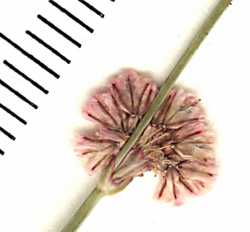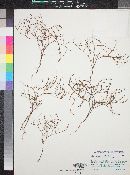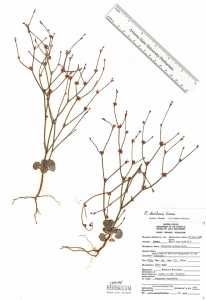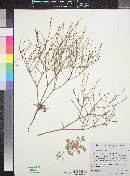Eriogonum davidsonii
|
|
|
|
Family: Polygonaceae
Davidson's buckwheat, more...Davidson's Wild Buckwheat
[Eriogonum molestum var. davidsonii (Greene) Jepson, moreEriogonum vimineum subsp. juncinellum (Gandog.) S. Stokes] |
Herbs, erect, 1-5 dm, glabrous, greenish to grayish. Stems: aerial flowering stems erect, 0.5-1.5(-2) dm, glabrous. Leaves basal; petiole 1-5 cm, floccose; blade round to reniform, (0.3-)1-2(-4) × (0.3-)1-2(-4) cm, densely white-tomentose abaxially, floccose to glabrate and mostly greenish adaxially. Inflorescences cymose, occasionally distally uniparous due to suppression of secondary branches, open, 5-40 × 5-35 cm; branches straight or nearly so, infrequently inwardly curved distally, glabrous; bracts 1-3 × 1-2 mm. Peduncles absent. Involucres appressed to branches, cylindric-turbinate, 3-4 × 2-2.5 mm, glabrous; teeth 5, erect, 0.2-0.3 mm. Flowers 1.5-2 mm; perianth white to pink or red, rarely yellow, glabrous; tepals monomorphic, oblong-obovate; stamens included, 1-1.5 mm; filaments pilose proximally. Achenes brown, 3-gonous, 2 mm. 2n = 40. Flowering May-Sep. Sandy to gravelly flats and slopes, mixed grassland, saltbush, chaparral, and sagebrush communities, oak and montane conifer woodlands; (400-)900-2600 m; Ariz., Calif., Nev., Utah; Mexico (Baja California). Eriogonum davidsonii is widespread and mostly common to occasionally abundant or weedy in Arizona, California, southern Nevada, and southern Utah. It is exceedingly variable. In the northern part of California, its range approaches that of E. luteolum var. luteolum, and the two can be difficult to differentiate. To the south, in Tulare County, the distinction between E. davidsonii and E. luteolum var. pedunculatum also is difficult. Specimens of Eriogonum davidsonii with curved inflorescence branches resemble E. cithariforme in the mountains of southern California, and care must be taken to separate E. davidsonii from its more robust relative, E. molestum in the San Jacinto Mountains of Riverside County. The disjunct populations in Utah and Arizona are somewhat different in appearance but presently do not seem worthy of taxonomic separation. The epithet juncinellum is available should recognition be desired. Seeds of Davidson's wild buckwheat were pounded into a meal and eaten dry by the Kawaiisu people of southern California (M. L. Zigmond 1981).
FNA 2005, Kearney and Peebles 1969 Duration: Annual Nativity: Native Lifeform: Forb/Herb General: Erect annual forb, 10-50 cm tall, glabrous, greenish to grayish with erect aerial flowering stems 5-15 cm tall, glabrous. Leaves: Basal, on petiole 1-5 cm, floccose, blade round to reniform, 1-2 cm long by 1-2 cm wide, densely white tomentose below, floccose to glabrous and mostly greenish above. Flowers: Cymose, occasionally only a single axis at each branching with suppression of secondary branches, open, 5-40 cm by 5-35 cm, branches straight or nearly so, infrequently inwardly curved distally, glabrous, with bracts 1-3 mm by 1-2 mm; involucres appressed to branches, cylindric-turbinate, 3-4 mm by 2-2.5 mm, glabrous, 5 teeth, erect, 0.2-0.3 mm; flowers 1.5-2 mm with a white to pink or red perianth, rarely yellow, glabrous; monomorphic tepals, oblong-obovate, stamens included, 1-1.5 mm, filaments pilose proximally. Fruits: Brown achenes, three sided. Ecology: Found on sandy or gravelly flats and slopes from 3,000-8,500 ft (914-2591 m); flowers May-September. Notes: Widespread and weedy, exceedingly variable in its growth forms, usually with erect glabrous branched slender stems, the flower clusters sessile and laterally positioned on stems with basal leaves, round to reniform, white woolly beneath and wavy margins. Ethnobotany: The seeds were pounded into a meal and eaten dry. Etymology: Eriogonum is from Greek erion, wool and phyllon, leaf, while davidsonii is named for Anstruther Davidson, a Scottish botanist. Synonyms: Erigonum molestum var. davidsonii, E. vimineum subsp. juncinellum Editor: SBuckley, 2010 |
|
|
|

